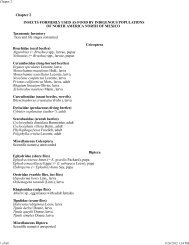Verticillium Wilt
Verticillium Wilt
Verticillium Wilt
- No tags were found...
You also want an ePaper? Increase the reach of your titles
YUMPU automatically turns print PDFs into web optimized ePapers that Google loves.
XHT1008Provided to you by:University of Wisconsin Garden FactsRevisedMay 5, 2013<strong>Verticillium</strong> <strong>Wilt</strong> of Trees and ShrubsBrian Hudelson, UW-Madison Plant PathologyWhat is <strong>Verticillium</strong> wilt? <strong>Verticillium</strong> wilt is a typically fatal disease thataffects a wide range of deciduous woody ornamentals in Wisconsin. Trees mostcommonly and severely affected are maple and ash. Other trees and shrubs suchas barberry, catalpa, elm, lilac, linden,smoke-tree and redbud susceptible. Inaddition, many herbaceous ornamentals,as well as vegetable crops (seeUniversity of Wisconsin Garden FactsXHT1146 “Vertcillium <strong>Wilt</strong> ofVegetables”), can be affected by thisdisease.Sudden yellowing, wilting and death of leavesand branches, particularly starting in onesection of a tree or shrub, is a typical symptomof <strong>Verticillium</strong> wilt.What does <strong>Verticillium</strong> wilt looklike? The first signs of <strong>Verticillium</strong> wiltthat you may notice are individualbranches that suddenly wilt and die.Affected branches may occur on one sideof the tree or may be scatteredthroughout the tree. If you carefully peelaway the bark of these branches, youmay see brown or green streaking in thesapwood just under the bark. Streakingis common in trees such as maple orredbud, but often is not visible in ash andlilac.Where does <strong>Verticillium</strong> wilt come from? <strong>Verticillium</strong> wilt is causedprimarily by two fungi, <strong>Verticillium</strong> dahliae and <strong>Verticillium</strong> albo-atrum. These fungiare commonly found in Wisconsin soils and in roots, branches and leaves of infectedplants. These fungi enter trees and shrubs through their roots and grow in the xylem(i.e., the water-conducting tissue) of plants where they lead to blockage of watermovement. This lack of water movement is what eventually leads to wilting.How do I save a tree or shrub with <strong>Verticillium</strong> wilt? Trees and shrubsinfected with <strong>Verticillium</strong> cannot be cured and will likely eventually die. However,you can extend the life of your plants by making sure that you water and fertilizeproperly. Make sure established trees and shrubs receive approximately one inch ofwater per week. If rainfall is insufficient, use a drip or soaker hose to applysupplemental water. Fertilize trees as needed, but be sure to base any fertilizationon a soil nutrient test. To prevent competition for water and nutrients, remove lawngrass within the drip line of your trees and shrubs (i.e., the edge of where thebranches extend) and replace it with shredded hardwood, pine or cedar mulch. Onheavy clay soils, use three inches of mulch. On other soils, use three to four inchesof mulch. Be sure to keep mulch two inches from the main trunks and crowns of
University of Wisconsin Garden Factstrees and shrubs. In addition, prune out dead branches as they occur. Dispose ofthese branches by burning (where allowed by local ordinance) or landfilling them.DO NOT bury or compost these branches. Be sure to clean your pruning toolsbetween cuts by dipping them for at least 30 seconds in a 10% bleach solution or(preferably due its less corrosive properties) 70% alcohol. Rubbing alcohol andmany spray disinfectants contain approximately this alcohol concentration.Decontaminating your tools will help prevent spread of <strong>Verticillium</strong> from branch tobranch, or more importantly from tree to tree, as you prune.Internal streaking in the sapwood of abranch is typical of <strong>Verticillium</strong> wilt.How do I avoid problems with<strong>Verticillium</strong> wilt in the future?The best way to avoid <strong>Verticillium</strong> wilt isto plant trees and shrubs that areimmune or resistant. Resistantdeciduous trees and shrubs [as adaptedfrom “Diseases of Trees and Shrubs,Second Edition” by W. Sinclair and H. H.Lyon (Comstock Publishing Associates,2005)] include apple, aspen, azalea,beech, birch, butternut, crabapple,dogwood, flowering quince, ginkgo,hackberry, hawthorn, hickory, holly,honeylocust, katsura tree, mountain-ash,oak, pear, poplar, sweetgum, sycamore,walnut, and willow. Conifers (e.g., pines,spruces and firs) appear to be immune tothe disease. Also, DO NOT use mulchesthat may have been produced frominfected trees or that are of unknown composition. Finally, immediately collect anddiscard leaves that have fallen from symptomatic trees. Both mulch and leaves arepotential sources of <strong>Verticillium</strong>.For more information on <strong>Verticillium</strong> wilt: See UW-Extension BulletinA2537, “Maple and Other Tree Disorder: <strong>Verticillium</strong> <strong>Wilt</strong>” (available athttp://learningstore.uwex.edu); University of Wisconsin Garden Facts XHT1146,“<strong>Verticillium</strong> <strong>Wilt</strong> of Vegetables” (available at http://hort.uwex.edu); or contact yourcounty Extension agent.© 1999-2013 by the Board of Regents of the University of Wisconsin System doing business as the division of Cooperative Extension of the University of Wisconsin Extension.An EEO/Affirmative Action employer, University of Wisconsin Extension provides equal opportunities in employment and programming, including Title IX and ADA requirements. This document can beprovided in an alternative format by calling Brian Hudelson at (608) 262-2863 (711 for Wisconsin Relay).References to pesticide products in this publication are for your convenience and are not an endorsement or criticism of one product over similar products. You are responsible for using pesticidesaccording to the manufacturer’s current label directions. Follow directions exactly to protect the environment and people from pesticide exposure. Failure to do so violates the law.Thanks to Jean Ferdinandsen, Patti Nagai and Scott Reuss for reviewing this document.A complete inventory of University of Wisconsin Garden Facts is available at the University of Wisconsin-Extension Horticulture website: http://hort.uwex.edu.
















